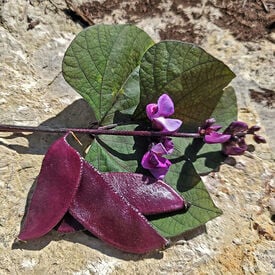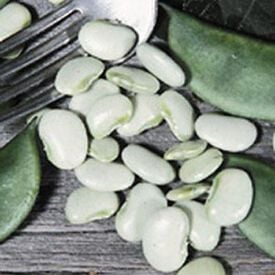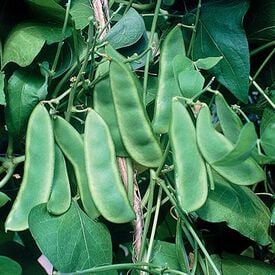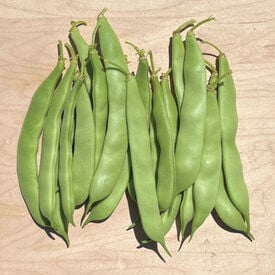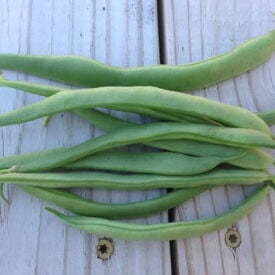Learn More
Calypso bean seeds, also known as "Yin Yang" beans for their striking black-and-white pattern, produce compact bush plants that typically grow 15 to 20 inches tall. These heirloom beans mature in about 70 to 90 days and are cherished for their creamy texture and mild, earthy flavor, making them ideal for soups, stews, and salads. Calypso beans are easy to grow, thriving in full sun and well-drained soil, and they offer good drought tolerance. Their unique appearance and reliable performance make them a favorite among gardeners and heirloom seed enthusiasts alike.
Flora de Junio bean seeds produce vibrant heirloom pole beans traditionally grown in Mexico, known for their striking maroon and white speckled pods and seeds. These vigorous climbing plants can reach a height of 6 to 8 feet, making them ideal for trellises or poles. They mature in approximately 90 to 100 days and are prized for their dual-purpose use as both fresh snap beans when young and dry beans when fully mature. Flora de Junio beans are celebrated for their rich, earthy flavor and resilience, thriving in warm climates with well-drained soil.
Bronco bean seeds produce vigorous bush plants that grow to about 18 to 24 inches tall and mature in approximately 55 to 60 days, making them a fast-growing option for gardeners. This variety is a high-yielding snap bean, known for its straight, slender, medium-green pods that are about 5 to 6 inches long. Bronco beans are tender, flavorful, and stringless, making them ideal for fresh eating, steaming, or freezing. They are also resistant to common bean diseases such as rust and mosaic virus, and perform well in a range of growing conditions with full sun and well-drained soil.
Jacob’s Cattle bean seeds grow into sturdy bush plants that reach about 18 to 24 inches in height and are prized for their early maturity, typically reaching harvest in 80 to 100 days. This heirloom variety, also known as Trout or Dalmatian bean, produces oval-shaped seeds with a distinctive white and deep maroon mottled pattern. Known for their rich, hearty flavor and meaty texture, Jacob’s Cattle beans hold up well during long cooking, making them excellent for baked beans, soups, and chili. They thrive in full sun and well-drained soil, offering dependable yields and good drought tolerance.
Dapple Grey bean seeds grow into compact bush plants reaching about 18 to 24 inches in height and typically mature in 85 to 95 days. This heirloom dry bean variety is known for its eye-catching gray seeds mottled with darker streaks, giving it a distinctive “dappled” appearance. Dapple Grey beans have a rich, hearty flavor and a firm texture, making them a popular choice for soups, stews, and chili. Easy to grow and well-adapted to a variety of climates, these beans thrive in full sun and well-drained soil, offering reliable yields and excellent storage quality.
Soldier bean seeds produce a traditional New England heirloom dry bean known for its creamy white color and distinctive reddish-brown marking near the hilum that resembles a toy soldier—hence the name. These bush-type plants are hardy and compact, typically reaching maturity in about 85 to 95 days, and they yield reliably even in cooler climates. Soldier beans are especially prized for their mild, earthy flavor and smooth texture, making them a favorite for baked beans, soups, and stews. Their excellent storage qualities and historical significance have kept them a staple in regional cooking for generations. Easy to grow and harvest, Soldier beans are a dependable and flavorful addition to any garden.
Bountiful bean seeds produce one of the earliest and most reliable bush snap beans, known for their exceptional productivity and tender, stringless pods. Introduced in the late 19th century, this heirloom variety remains popular for its rich flavor, crisp texture, and consistent performance in a wide range of climates. The compact, bushy plants grow about 12 to 18 inches tall and do not require staking, making them perfect for small gardens or raised beds. Bountiful beans are easy to harvest and ideal for fresh eating, canning, or freezing. Their early maturity and dependable yields make them a favorite among home gardeners and market growers alike.
Jacob’s Cattle Gold bean seeds produce robust bush plants that grow to about 18 to 24 inches tall and mature in approximately 85 to 95 days. A golden-hued variant of the traditional Jacob’s Cattle bean, this heirloom variety features beautiful tan seeds with maroon speckles and splashes. Renowned for their creamy texture and rich, slightly sweet flavor, Jacob’s Cattle Gold beans are ideal for baking, soups, and slow-cooked dishes. They perform well in a range of garden soils, thrive in full sun, and offer consistent yields, making them a favorite among home gardeners and heirloom collectors.
Kenearly Yellow Eye bean seeds produce bush-type plants that grow to about 18 to 24 inches tall and are known for their high yields and disease resistance. These heirloom beans mature in approximately 85 to 95 days and are distinguished by their creamy white seeds with a distinct yellow "eye" marking. Valued for their mild, buttery flavor and smooth texture, Kenearly Yellow Eye beans are excellent for soups, stews, and baked dishes. They thrive in well-drained soil and full sun, and their compact growth habit makes them easy to harvest and ideal for small garden spaces.
Pink Half Runner bean seeds produce a traditional Appalachian favorite known for its tender pods and flavorful pink-mottled seeds. These beans grow as semi-vining plants—hence the term "half runner"—which means they can be grown with or without support, though a short trellis or fence can improve yields and ease of harvest. The pods are medium-length, stringy when mature, and typically harvested young for snap beans or allowed to mature for shelling or dry use. Pink Half Runners are celebrated for their rich, old-fashioned flavor, making them ideal for slow-cooked dishes and canning. Adaptable and prolific, they perform well in a range of growing conditions and continue to be a cherished staple in many Southern gardens.
Whiskey Mountain bean seeds produce a rare and distinctive heirloom pole bean known for its vigorous growth, striking appearance, and excellent flavor. The plants climb tall and robustly, requiring support, and yield long, tender pods that can be enjoyed as fresh snap beans or allowed to mature into colorful dry beans. The dry beans often feature unique markings and a rich, earthy taste that makes them ideal for soups and stews. Named after the scenic Whiskey Mountain region, this variety is valued for both its resilience in diverse growing conditions and its ornamental appeal in the garden. With its combination of beauty, hardiness, and culinary versatility, Whiskey Mountain is a treasured choice for gardeners seeking something special.
Ruby Moon Hyacinth Bean, also known as Lablab purpureus or simply Hyacinth Bean, is a unique and versatile legume known for its vibrant appearance and culinary potential. This heirloom variety is named for its striking ruby-red pods and dark green foliage, making it an attractive addition to both ornamental and edible gardens. Ruby Moon Hyacinth Beans are typically grown as annuals, but in tropical regions, they can be perennial. In terms of taste, the young pods and seeds of Ruby Moon Hyacinth Bean are edible and have a mild, nutty flavor similar to green beans. They can be consumed both raw and cooked. However, it's important to note that mature seeds contain toxic compounds and should not be eaten without proper processing. Ruby Moon Hyacinth Beans have a rich history, with their cultivation dating back centuries, primarily in Asia and Africa. They are valued not only for their culinary uses but also for their ability to fix nitrogen in the soil, enhancing soil fertility. This plant is categorized as a warm-season annual and typically matures in about 60-90 days, depending on growing conditions. The size of the Ruby Moon Hyacinth Bean plant can vary, but it generally reaches a height of 6-10 feet, making it suitable for trellises or fences. When it comes to yield, you can expect approximately 10-15 pounds of pods per plant or around 800-1,200 pounds per acre under ideal conditions. These beans thrive in full sun and well-drained soil, and they require a warm climate to grow successfully. Adequate moisture and support for climbing are essential for a bountiful harvest. With proper care, Ruby Moon Hyacinth Beans can be a delightful addition to your garden, offering both visual appeal and a tasty, nutritious addition to your plate.
Cinnabar Mountain bean seeds produce striking, ornamental pole beans known for their vivid scarlet flowers and long, slender pods. This variety is not only visually appealing but also productive, climbing vigorously and yielding beans that can be eaten young as snap beans or left to mature for dry beans. Named after the cinnabar-red hues of its blooms, it attracts pollinators like hummingbirds and bees, making it a beautiful and beneficial addition to gardens. The plants thrive in warm weather with full sun and well-drained soil, and they require sturdy trellising due to their vigorous vining habit. Cinnabar Mountain beans combine aesthetic charm with culinary value, making them a favorite for both ornamental and edible landscapes.
Quicksilver Mountain bean seeds grow into a vigorous pole bean variety prized for its elegant, silver-speckled dry beans and reliable performance in the garden. The tall, climbing vines produce long, slender green pods that can be harvested young as tender snap beans or left to mature into striking dry beans with a smooth, pale base marked by silvery patterns. Known for their creamy texture and rich, nutty flavor when cooked, Quicksilver Mountain beans are ideal for hearty dishes like soups, stews, and casseroles. This variety thrives in full sun with support from a trellis or pole structure and is favored by gardeners for both its visual appeal and culinary quality.
The Eastland bean, scientifically known as Phaseolus vulgaris 'Eastland,' is a popular variety of bush bean that hails from the United States. It is highly esteemed for its exceptional taste and ease of cultivation. Eastland beans belong to the family Fabaceae and are a warm-season crop commonly grown in gardens and small-scale farms. In terms of taste, Eastland beans are celebrated for their tender, crisp texture and rich, earthy flavor. They are a delight to eat both raw and cooked. The pods of Eastland beans are of medium size, typically measuring around 4-5 inches in length. The plants themselves are compact and bushy, making them suitable for smaller gardens and spaces. These beans have a relatively short maturity period, typically taking around 70-75 days from planting to harvest. The beans are known for their vibrant green color, making them visually appealing as well. Eastland beans are generally resistant to common bean diseases such as bean mosaic virus and rust. They are known to provide a good yield per acre, often ranging from 800 to 1,200 pounds of beans per acre, depending on growing conditions and care. Proper spacing is crucial for their growth, with plants typically spaced 3-4 inches apart in rows that are about 18-24 inches apart. These beans thrive in well-drained soil with full sun exposure and require regular watering to maintain consistent moisture levels in the soil. Overall, Eastland beans are a favorite among gardeners and farmers for their taste, disease resistance, and relatively quick harvest time.
The small Woods Prolific Lima Bean is perfect for canning, freezing and as a dry bean! The bean plant produces thick green pods with small creamy white seeds. Each pod contains about 3 to 4 seeds. The Woods Prolific Lima Bean prefers full sun and has early to mid maturity and produces continuously until frost.
The Taylor Dwarf Horticulture Bean, also known as the Taylor Horticulture Bean or simply Taylor Dwarf Bean, is a popular heirloom bean variety prized for its delicious flavor and historical significance. This bean variety has a rich history dating back to the early 19th century in the United States. It is a bush-type bean, which means it grows in a compact, bushy form rather than climbing like pole beans. Taylor Dwarf Horticulture Beans are highly regarded for their superb taste, which is characterized by a creamy texture and a slightly nutty, earthy flavor. The beans are typically harvested when they are young and tender, making them ideal for fresh consumption or canning. The pods of the Taylor Dwarf Horticulture Bean are medium-sized and typically measure around 4-5 inches in length. The plants themselves are relatively small and bushy, reaching a height of about 18-24 inches, which makes them suitable for smaller gardens or container gardening. This variety has a relatively short maturity period, typically taking around 55-60 days from planting to harvest. The beans themselves are a pale cream or off-white color. Taylor Dwarf Horticulture Beans are known for their good disease resistance, which helps ensure a healthy crop. In terms of yield, you can expect a respectable harvest of beans per row, with each plant producing multiple pods. Proper spacing between plants should be around 4-6 inches apart in rows that are spaced about 18-24 inches apart. These beans thrive in well-drained soil with good organic matter content and prefer full sun for optimal growth. Adequate moisture and regular harvesting will help ensure a bountiful crop of these delicious and historically significant beans.
Greencrop beans are a classic heirloom variety renowned for their distinctive features and reliable performance. Originating in the early 20th century, this variety has been favored by gardeners for its robust growth and high productivity. Greencrop beans are characterized by their striking green color, smooth texture, and uniform shape. The plants are typically bush-type, reaching a height of about 18 to 24 inches, which makes them suitable for smaller garden spaces and easier to manage without extensive staking. The beans themselves are known for their crisp and tender texture, combined with a mildly sweet and fresh flavor that enhances a variety of dishes. Harvesting is best done when the pods are young and firm, usually in mid to late summer, to ensure optimal taste and texture. Greencrop beans are valued for their high yield and resistance to common diseases, making them a dependable choice for both home gardeners and market growers. With their appealing flavor, compact growth habit, and consistent performance, Greencrop beans remain a popular and practical selection for vegetable gardens.











